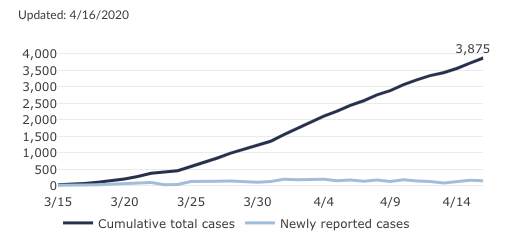Safer at Home Order Extended to May 26
- Share
- Tweet
- Pin
- Share

Gov. Tony Evers has extended Wisconsin’s Safer at Home order to May 26. The original order was made March 25 and scheduled to expire April 24. Evers also ordered school buildings closed for the remainder of the 2019-2020 school year.
The White House Thursday released guidelines for states to consider re-opening businesses and schools. Those guidelines include a two-week downward trajectory of new cases. Wisconsin now reports 3,875 cases of Covid-19, including 154 new cases reported Thursday, and 197 deaths. But just across the border in northern Illinois there have been more than 20,000 confirmed cases and 1,000 deaths.

“A few weeks ago, we had a pretty grim outlook for what COVID-19 could mean for our state, but because of the efforts of all of you, Safer at Home is working. That said, we aren’t out of the woods just yet,” Evers said in a statement Thursday. “As I’ve said all along, we are going to rely on the science and public health experts to guide us through this challenge. So, as we extend Safer at Home, I need all of you to continue doing the good work you’ve been doing so we can keep our families, our neighbors, and our communities safe, and get through this storm together.”
Evers announced the extension as part of a larger announcement that he has joined the governors of six other midwestern states to partner in battling the coronavirus.
Governors Tony Evers (WI.), Gretchen Whitmer (MI.), Mike DeWine (OH), Tim Walz (MN.), J.B. Pritzker (IL.), Eric Holcomb (IN.) and Andy Beshear (KY) announced a partnership on Thursday aimed at reopening the economy in the Midwest region.
“Today, we are announcing that Michigan, Ohio, Wisconsin, Minnesota, Illinois, Indiana, and Kentucky will work in close coordination to reopen our economies in a way that prioritizes our workers’ health,” the governors said in a statement. “We look forward to working with experts and taking a fact-based, data-driven approach to reopening our economy in a way that protect families from the spread of COVID-19. Our number one priority when analyzing when best to reopen our economy is the health and safety of our citizens. We will make decisions based on facts, science, and recommendations from experts in health care, business, labor, and education.”
The governors said they will look at four factors in determining when to reopen economies, including:
- Sustained control of the rate of new COVID-19 infections and hospitalizations
- Enhanced ability to test and trace
- Sufficient health care capacity to handle resurgence
- Best practices for social distancing in the workplace
Residents don’t need permission to leave their homes, but are only allowed to do so for specific things, like going to the grocery store or to the doctor. People are allowed to exercise outside, but are required to keep six feet between themselves and others, unless they live with the person.Playgrounds will also remain closed.
Essential businesses and operations, such as hospitals, grocery stores, hardware stores and pharmacies, will continue operations.
The order includes minor changes allowing certain activities to begin:
- Public libraries can provide curbside pickup of books.
- Golf courses can open with more spread out tee times.
- Non-essential businesses will be allowed to do deliveries, mailings and curbside pick-up.
- Arts and crafts stores can do curb-side pick-up for materials used to make masks.
- Aesthetic lawn care or construction is allowed as long as it’s done by one person.




